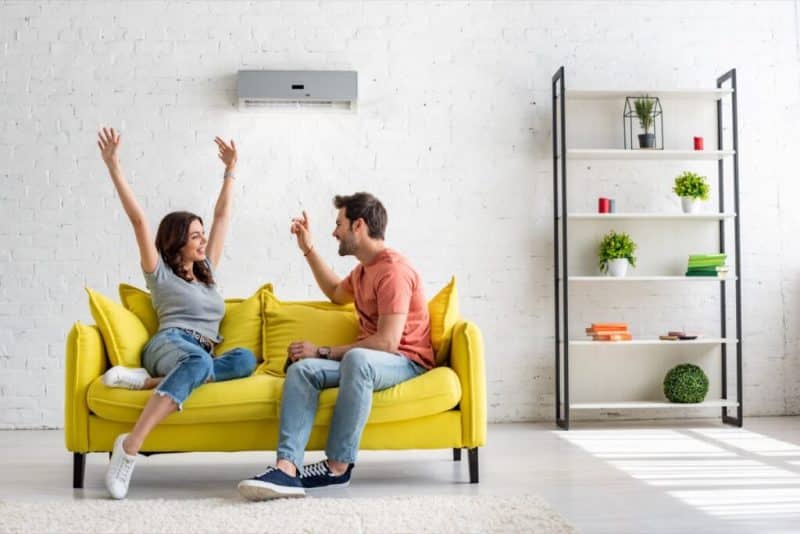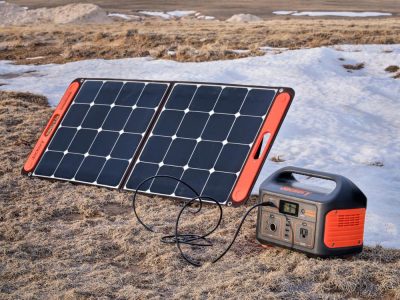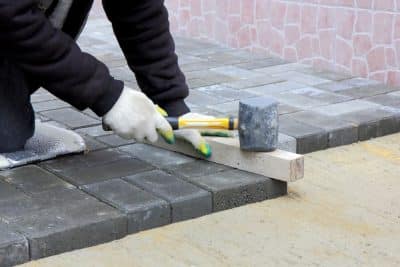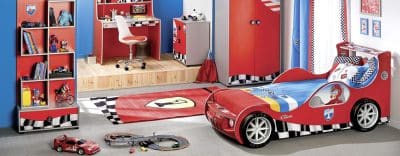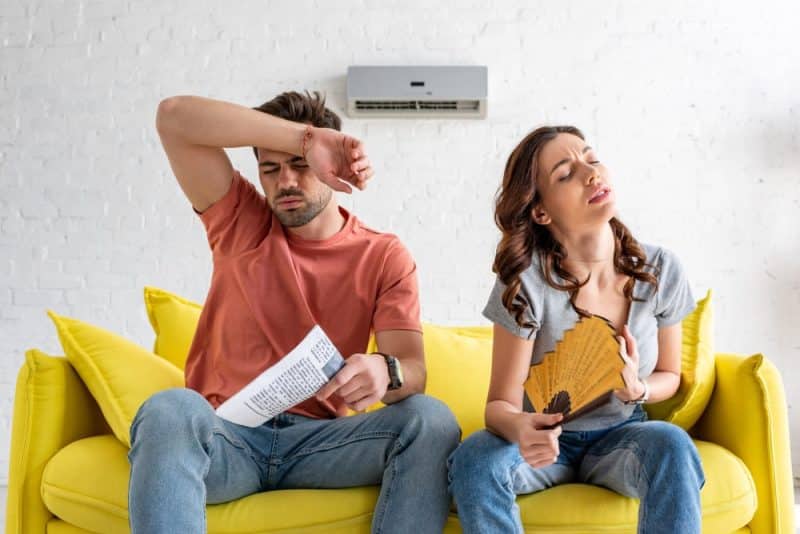
As summer approaches, even the most charming homes can feel like saunas. You might step inside expecting relief from the heat, only to be met with the same stifling temperatures. This frustration isn’t necessarily due to an old aircon unit. By learning how to maximize air conditioning efficiency, you can transform your living space into a cool, comfortable haven, even during the hottest months.
Optimizing Your Air Conditioning System
Proper placement and optimization of your air conditioning system (aircon) are crucial for achieving maximum cooling efficiency and comfort. Here are detailed guidelines for positioning both the indoor and outdoor units of your aircon, along with tips for maximizing airflow.
Proper Placement of the Air Conditioner
Indoor Unit: Place the aircon indoor unit in a central location within the room to ensure even distribution of cool air, maintaining a consistent temperature throughout the space. Avoid positioning the aircon directly in front of seating areas to prevent discomfort from the constant flow of cold air. Instead, place it where the airflow can circulate freely without directly hitting occupants. Additionally, ensure the indoor unit is not near heat-generating appliances like ovens, stoves, or electronics, as heat from these sources can strain the aircon, forcing it to work harder and reducing its efficiency.
Outdoor Unit: Install the aircon’s outdoor unit in a shady area that receives minimal direct sunlight. Excessive sunlight can heat the unit, causing it to work harder to cool the refrigerant, thereby increasing energy consumption. The outdoor unit needs sufficient airflow to dissipate heat effectively, so avoid placing it in corners or enclosed spaces where air circulation is restricted. An open, well-ventilated area is ideal. If possible, place the outdoor unit on an elevated platform to protect it from debris and ensure better airflow, also helping to prevent potential flooding damage during heavy rains.
Maximize Airflow
Outdoor Unit Placement: Ensure the aircon’s outdoor unit is not placed near walls, fences, or large plants that can obstruct airflow. Proper airflow around the unit is essential for efficient operation and heat dissipation. Keep the area around the outdoor unit clear of debris, leaves, and other obstructions. Regularly check and clean the surroundings to maintain optimal airflow.
Indoor Airflow Optimization: Position the indoor unit in a way that promotes natural circulation of air. Avoid placing it in confined spaces or behind large furniture pieces that can block airflow. Ensure that air vents and registers are not blocked by furniture, rugs, or curtains, as unobstructed vents allow for better air distribution throughout the room. Additionally, use ceiling fans to enhance airflow. Fans help distribute cool air more evenly and can reduce the load on the aircon, improving its efficiency.
Set the Right Temperature
Setting the right temperature on your aircon is crucial for both comfort and energy efficiency. While it might be tempting to set the thermostat to very low levels on a hot day, this approach is not the most effective or economical way to cool your home. Here are some detailed tips on how to set and manage your thermostat for optimal performance:
Optimal Temperature Range: Aim to keep your thermostat set between 72-75°F (22-24°C) when you are at home. This range is typically comfortable for most people and allows your aircon to cool your home effectively without excessive energy use. When you are not at home, consider setting the thermostat a few degrees higher, around 78-80°F (25-27°C). This reduces the workload on your aircon and conserves energy, leading to cost savings.
Energy Consumption Considerations: According to the U.S. Department of Energy, each degree you lower the thermostat can increase energy consumption by about 3-5%. Therefore, keeping the thermostat at a moderate setting can significantly reduce your energy bills. Cranking the thermostat down to very low temperatures doesn’t cool your home faster but increases the energy load. The aircon will run longer to reach such low temperatures, consuming more energy and increasing wear and tear on the unit.
Smart Thermostats: Investing in a programmable thermostat can help automate temperature adjustments based on your schedule. Set the thermostat to lower the temperature before you arrive home and to increase it when you leave. This ensures comfort without manual intervention and maximizes energy efficiency. Advanced thermostats can learn your habits and preferences over time, adjusting settings automatically to optimize comfort and efficiency. These devices can also be controlled remotely via smartphone apps, giving you the flexibility to manage your home’s temperature from anywhere.
Seasonal Adjustments: During the summer months, set the thermostat to the recommended range of 72-75°F when you’re home. Make sure to utilize ceiling fans to help circulate cool air and enhance comfort. In winter, set the thermostat to a lower range, around 68-70°F when you’re at home and awake. Lower the temperature even further when you’re asleep or away to save on heating costs.
Humidity Control: Using a dehumidifier in conjunction with your aircon can help maintain comfort at slightly higher temperatures. Lower humidity levels make the air feel cooler, allowing you to set the thermostat a bit higher without sacrificing comfort. Some modern aircon units come with built-in humidity control settings. Utilize these features to manage indoor humidity levels effectively, enhancing overall comfort and efficiency.
Benefits of Inverter Air Conditioners: Incorporating an inverter air conditioner into your home can significantly enhance comfort and energy efficiency. These units use variable speed compressors to maintain consistent temperatures, avoiding the frequent on-off cycles of traditional units and resulting in better efficiency and comfort. They use less energy, leading to substantial savings on utility bills. Inverter air conditioners also cool and heat your home more quickly and operate more quietly due to the smoother operation of the compressor. This reduced wear and tear extends the lifespan of the unit, decreasing the frequency of repairs and replacements.
By setting your thermostat to a reasonable temperature and utilizing programmable or smart thermostat features, you can maintain a comfortable indoor environment while minimizing energy consumption. Making informed adjustments based on your presence at home, seasonal changes, and humidity levels will help you achieve the perfect balance between comfort and cost savings.
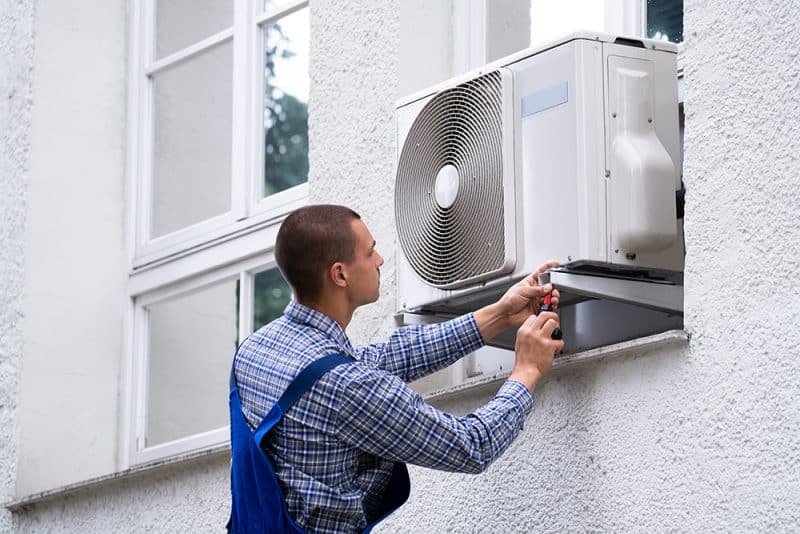
Seal Leaks and Insulate Your Home
Ensuring your home is well-sealed and properly insulated is crucial for the efficient operation of your aircon. A home that minimizes air leaks and maximizes insulation will maintain a cooler indoor environment with less energy consumption. Here’s how you can achieve this:
Inspect and Seal Drafts: Check all doors and windows for drafts. Common areas where leaks occur include gaps around frames, sills, and moving parts. Use weatherstripping or caulking to seal any detected leaks. This prevents cool air from escaping and warm air from entering. Don’t forget to inspect other potential leak points such as electrical outlets, mail slots, and plumbing vents. Sealing these areas can also contribute to better temperature control.
Enhance Insulation: The attic is a significant source of heat transfer. Adding or upgrading insulation in your attic can greatly reduce the amount of heat that enters your home, making it easier for your aircon to maintain a cool temperature. Consider materials like fiberglass, cellulose, or spray foam for effective insulation. Ensure that your walls and floors are also properly insulated. Insulated walls prevent external heat from penetrating indoor spaces, and insulated floors can help maintain a consistent temperature throughout your home.
Window Treatments: Using heavy curtains or blinds can help block out heat from the sun, especially during the hottest parts of the day. Reflective or thermal-backed window treatments are particularly effective at reducing heat gain. Applying window films can also reduce heat transfer. These films are designed to reflect a significant portion of solar energy, helping to keep your home cooler.
Seal and Insulate Ductwork: Leaky ductwork can lead to significant energy losses. Inspect your ducts for leaks and seal them with duct mastic or metal tape. Properly sealed ducts ensure that cool air is delivered efficiently throughout your home. In addition to sealing, insulating your ductwork, especially in unconditioned spaces like attics and basements, can prevent energy loss and improve the overall efficiency of your aircon system.
Regular Maintenance: Over time, seals and insulation can degrade. Regularly check the condition of weatherstripping, caulking, and insulation, and replace or repair as needed to maintain efficiency. Consider having a professional energy audit performed on your home. An expert can identify hidden leaks and insulation issues that might not be immediately apparent.
By meticulously sealing leaks and improving insulation, you can significantly enhance the efficiency of your aircon system. This not only keeps cool air inside and prevents warm air from infiltrating but also reduces your energy bills and contributes to a more comfortable living environment.

Regular AC Maintenance and Cleaning
Maintaining your air conditioning (AC) system is crucial for ensuring its optimal performance and longevity. Regular AC maintenance not only enhances the efficiency of your system but also helps prevent costly repairs and extend the unit’s lifespan. Here’s a comprehensive guide to keeping your AC in top-notch condition:
Routine Filter Maintenance: The air filter in your AC system should be cleaned or replaced every 1-3 months. A clogged or dirty filter restricts airflow, causing the system to work harder and less efficiently. Regularly maintaining the filter ensures proper airflow and improves indoor air quality.
Professional Annual Check-Ups: It’s wise to schedule an annual check-up with a qualified technician. During this inspection, the technician will clean and inspect various components of the system, check for refrigerant leaks, and ensure all parts are functioning correctly. This proactive approach can identify minor issues before they escalate into major problems, saving you from expensive repairs.
Comprehensive System Inspection: Both the evaporator and condenser coils should be inspected and cleaned regularly. Dirty coils reduce the system’s ability to absorb and release heat, leading to increased energy consumption and reduced cooling efficiency. Checking the refrigerant levels is essential for the AC to operate efficiently. Low refrigerant levels can indicate a leak, which needs to be addressed promptly to avoid damage to the compressor. Calibrating your thermostat ensures that your AC system maintains the desired temperature accurately. An improperly calibrated thermostat can lead to inefficient cooling and higher energy bills.
Additional Maintenance Tasks: Ensure that the ductwork is clean and free from obstructions. Leaks or blockages in the ducts can significantly impact the system’s efficiency and cooling performance. Inspect and tighten electrical connections, as loose or faulty wiring can lead to system failures and potential safety hazards. Lubricate the moving parts of the AC system, such as the fan and motor bearings, to reduce friction and wear. This helps the system run more smoothly and extends the lifespan of the components.
Seasonal Maintenance: Before the start of the cooling season, conduct a thorough inspection and maintenance of your AC system to ensure it’s ready to handle the increased demand. This includes checking the system’s overall condition, cleaning the outdoor unit, and testing the system’s performance. After the cooling season, perform a final check-up to prepare the system for the off-season. Clean the unit, replace the filter, and cover the outdoor unit to protect it from debris and harsh weather conditions.
By adhering to a regular maintenance schedule and addressing any issues promptly, you can keep your AC system running efficiently and reliably. Regular maintenance not only improves energy efficiency and indoor air quality but also extends the life of your aircon, providing you with comfort and peace of mind throughout the cooling season.
In conclusion, by implementing these strategies and tips, you can maximize air conditioning efficiency, ensuring a cooler, more comfortable home while also saving on energy costs. Proper placement, regular maintenance, and mindful temperature settings are key to optimizing your aircon’s performance. Embrace these practices to enjoy a refreshing and efficient cooling system all summer long.
FAQs
1. How frequently should my air conditioner be checked by a professional?
It’s advisable to schedule a professional inspection and servicing of your air conditioner annually, preferably just before the summer season begins to ensure it’s running efficiently.
2. Can I handle air conditioner maintenance tasks on my own?
Homeowners can perform simple maintenance tasks such as cleaning or replacing air filters. However, more intricate maintenance tasks should be conducted by professional technicians to ensure safety and effectiveness.
3. What does short cycling mean for my air conditioner, and is it harmful?
Short cycling is when your air conditioner turns on and off in quick succession. This issue can cause significant wear and tear on the system, reducing its overall lifespan and efficiency.
4. Does the capacity of my air conditioning unit affect its performance?
Absolutely, the capacity of your AC unit is critical. A unit that’s too small will struggle to cool your home effectively, while one that’s too large will turn on and off too frequently, leading to wasted energy and potential system damage.
